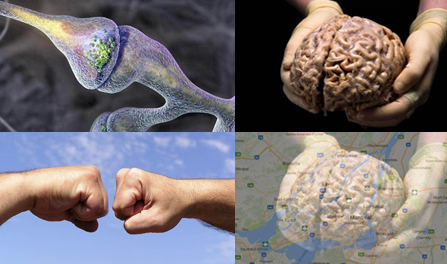Friday, 14 July 2017
Metaphors for the Brain’s Anatomy and Functioning

When I’m making presentations about the human brain to live audiences, the quick, easy method I often use to show them a three-dimensional model of a brain synapse is to hold my two fists facing each other, very close together, but not touching. One fist thus represents the axon of the pre-synaptic neuron, while the other represents a dendritic spine on the post-synaptic neuron. This macro model of a synapse is about 20 centimetres long.
In comparison, a real synapse in a mammalian brain is about 1 micron (one thousandth of a millimeter) long. This estimate includes the terminal button (the swelling at the tip of the axon), the dendritic spine (the swelling on a dendrite of the second neuron which receives the connection from the axon of the first), and the synaptic gap (the space between them). Into this gap, the axon of the pre-synaptic neuron releases its neurotransmitters, which immediately bind to the receptors in the membranes of the post-synaptic neuron’s dendritic spine.
To extend the metaphor, let’s say that an actual human brain is about 20 centimetres long. So, pop question: if the model synapse composed of my fists is about 20 centimetres long, how long would a model of the entire brain be on that same scale? The answer: 0.2 m x 0.2 m / 0.000 001 m = 40 000 m = 40 km! In other words, approximately the length of Montreal Island, where I live, in Quebec. (Not one to shrink from a PhotoShop challenge, I created the little set of photos above to let you visualize this metaphor more easily.)
Moving on from the anatomical size of the brain, we need some other metaphor to represent the complexity of its incessant electrical activity. There are about 85 billion neurons in the human brain, each of which can receive up to 10,000 synapses. Thus, in a matter of milliseconds, electrical impulses travel across literally trillions of synaptic connections in the brain.
The best metaphor that I have found for this incredibly complex electrical flow comes from Sebastian Seung, who studies the human connectome on the microscopic scale. He likens the brain.s electrical flows to a stream rushing through a forest. Just like the configurations of the brain’s electrical activity, the flow patterns in the water are never the same from one moment to the next. But they do reveal some “strange attractors”—eddies whose general shape is the same at certain locations, behind certain rocks. Similarly, the large networks in the human brain are connected by hubs that, though never entirely the same, can be recognized in certain situations. 
The beauty of this metaphor is that it also depicts phenomena occurring on two different time scales. Just as the water’s flow is constrained by the shape of the underlying stream bed, the electrical flows in the brain are constrained by the major neural pathways that were laid down as the human brain evolved from that of other species. But on a far shorter time scale, if you go back and visit the same stream after just a few years, the current will have eroded its banks and moved some rocks around in the stream bed. And that’s exactly like what happens in your own brain in the course of a lifetime: all that constant neural activity causes permanent changes in the configuration of its neural networks, so that you are always a slightly different person from one day to the next.
From the Simple to the Complex | Comments Closed








